Ascential, the media and events company behind Cannes Lions, has entered into an agreement to acquire the commercial assets of Effie, the global benchmark in marketing effectiveness.
Pending regulatory approval, Effie will join Ascential’s LIONS Division, bringing with it more than 55 global, regional, and national Effie Awards programs, covering over 125 markets.
In acquiring Effie, Ascential also plans to undertake a long-term partnership with its not-for-profit arm, Effie Worldwide, which provides research and resources on effective marketing strategy. Moving forward, the organization will become The Effie LIONS Foundation and will focus on educating the next generation of talent, offering training for all marketing students, particularly those underrepresented in the marketing community. The Foundation will also provide a home for LIONS’ existing not-for-profit initiatives and access to some of the LIONS Division’s digital products.
Philip Thomas, CEO of Ascential, commented: “The coming together of LIONS and Effie is a powerful testament to the fact that effectiveness and creativity in marketing are inextricably linked. All enlightened businesses know that creative, effective marketing drives growth. This historic partnership will complement the insights and intelligence on marketing and creative effectiveness that LIONS already offers via WARC, The Work, and Contagious, providing marketing leaders worldwide with the data and evidence they need to make the case for creative marketing that matters. Meanwhile, the creation of The Effie LIONS Foundation, Inc. will educate and inspire our industry and broaden the opportunities available to everyone to build a career in creativity and marketing.”
Traci Alford, President and CEO of Effie Worldwide, commented: “We are excited to join LIONS with such a complementary, yet distinct, portfolio of brands. Closer collaboration between Effie, as the definitive marketing effectiveness benchmark globally, and the LIONS brands is an exciting prospect for the industry. Our ability to share insights and find synergies in our data will help to dissect the role creativity plays in driving marketing effectiveness overall. Together we will be able to better understand the key drivers of growth and ultimately help all businesses succeed.”
Headquartered in New York, with offices in Beijing and the UK, Effie has a network of 59 partners covering over 125 markets. Effie will continue to be led by Traci Alford, President and CEO of EffieWorldwide.
As the official representative of Cannes Lions in the UAE, Motivate Val Morgan warmly welcomes this exciting new partnership.
Source: Cannes Lions Press Release
According to a report by WARC Media, global advertising spend is poised for significant growth in 2024, potentially doubling compared to previous years and exceeding $1 trillion for the first time. This surge is largely attributed to the widespread adoption of AI in advertising strategies, with major players like Amazon and Google heavily investing in AI-based advertising solutions to drive substantial revenue growth in the future.
Paul Stringer, an expert at WARC, highlights that while AI has proven beneficial for advertising, its rapid expansion raises important questions about the relationship between humans and machines, the influence of tech platforms, and the future landscape of news and entertainment on the internet. Without proper oversight, there is a risk of widespread AI-generated misinformation, which could make brands increasingly wary of advertising due to concerns about brand safety and ad fraud.
Meanwhile, a study conducted by YouGov and reported by the Video Advertising Bureau (VAB) revealed that 86% of respondents feel overwhelmed by excessive ads on webpages, leading them to ignore advertisements. Additionally, 72% stated that annoying or intrusive ad experiences have negatively impacted their perception of a brand, while 66% indicated that such experiences make them less likely to purchase from the brand in the future, emphasizing the importance of delivering non-intrusive advertising content.
In response to these challenges, WARC addressed the issue in their latest study on the media signaling strength of various advertising mediums, which assesses the perceived cost and scale of an advertising channel in enhancing brand attributes. The study shows that Linear TV currently leads in media signaling strength at 46%, closely followed by cinema at 41% in all age group where as cinema leads in signaling strength for the age group 16-34 with 43%. These mediums remain uniquely positioned to deliver high-impact advertising to a mass audience, crucially in a brand-safe environment, and are likely to positively influence consumers’ perceptions of a brand.
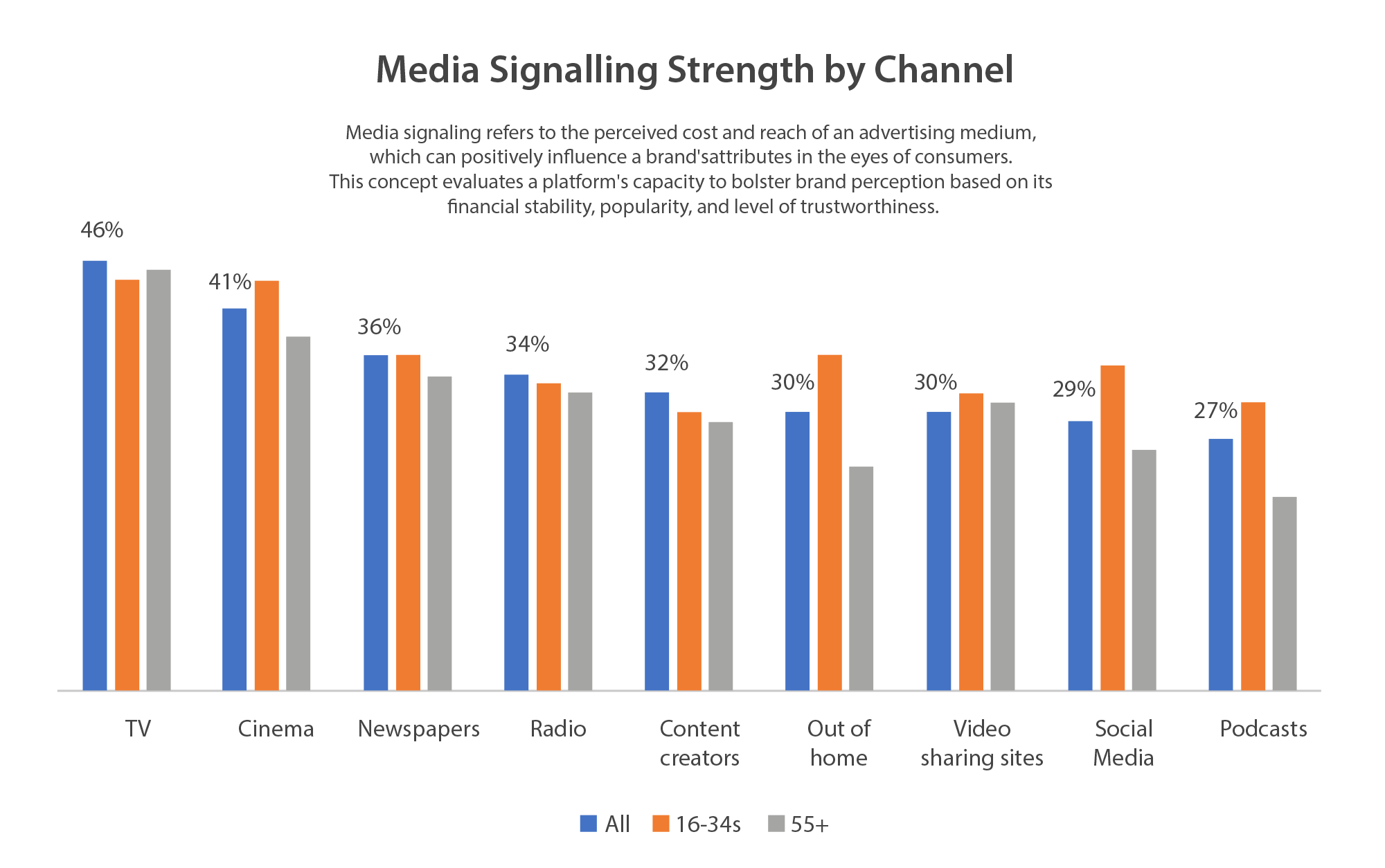
While TV currently leads in signaling strength by 5%, it’s noteworthy that with the increasing adoption of attention measurement by brands and agencies to evaluate creative and media quality, cinema is projected to surpass TV in media signaling strength soon. Consumers are increasingly engaging with high-quality, long-form content on premium video platforms, where cinema advertising proves particularly effective in capturing viewer attention for extended periods.
This effectiveness is supported by findings from NCM and Lumen research, indicating that cinema advertising generates longer ‘eyes-on’ viewing compared to other digital and social channels. A recent study by Val Morgan Australia and Amplified Intelligence further reinforces this, stating that cinema delivers a minimum of 49 days of memory encoding from just 10 seconds of an ad, reaching an audience where half are under 40.
In conclusion, brands and agencies are realizing, backed by proper research, that running their ads on brand-safe premium platforms maintains their brand perception as intended, capturing the right audience with minimal wastage.
Sources: WARC, Video Advertising Bureau (VAB), Mi3, YouGov
The Global Lions Creativity Report will celebrate sustained creative success
Winners will be announced throughout the week of LIONS Live
Cannes Lions has announced that it will release a Global Lions Creativity Report of the Decade in June to celebrate and recognise sustained creative success.
It is the first time in Cannes Lions’ history that data from across ten years will be used to compile a global rankings and benchmarking report. The winners will be announced throughout the week of LIONS Live, 22-26 June, with acceptance speeches and reels of work screened live to the world through the platform.
About the report, Simon Cook, Managing Director, Cannes Lions, said: “Every year, our global juries only award around 3% of entries, which means if you win a Lion – whatever the metal – it’s recognition of truly game-changing, creative excellence. This first of its kind report will recognise and celebrate those that have performed to that level, consistently, over the last decade. It will celebrate a body of work that has made the recipients the most creative companies in the world. We hope the report will also serve as a valuable and inspiring learning resource and clearly show what sustained creative success looks like.”
The Global Lions Creativity Report of the Decade will announce winners in the following categories:
The report is being produced together with Cannes Lions’ sister company, WARC, who will provide editorial commentary and insights on the rankings. The full report will be made available to everyone after the results have been announced at LIONS Live, the new digital experience and platform for the creative community.
LIONS Live will unite the world’s global creative community with a free agenda of live-streamed and on-demand content running from 22-26 June.
Click here for further information on LIONS Live.
Source: Cannes Lions (Press Release)
Indian language movies have come a long way over the last few years!
From their initial standard three hour long flicks featuring action-packed drama, tears, catchy and sing-along songs, extravagant dancing and colourful traditional costumes – being produced solely for domestic consumption, to having varied time lengths dictated by their content, and witnessed across the globe in countries such as United States, Canada, Australia, Taiwan, China, Russia, Turkey – in either their original form with subtitles or dubbed versions of its original form.
Movies from India are no longer restricted to Bollywood which produces movies solely in the national language (Hindi). India, in line with the varied languages and dialects in the country, is also home to other powerhouse movie industries such as:
Bollywood – Mumbai-based Hindi language film industry, India
Pollywood – Punjabi language film industry in India and Pakistan
Bhojiwood – Film industry of Bihar and Uttar Pradesh, India in Bhojpuri language
Chhollywood – Chhattisgarhi language film industry based in Chhattisgarh, India
Tollywood – Bengali film industry in West Bengal, India/Telugu film industry in Andhra Pradesh and Telangana
Kollywood – Tamil language film industry, based in Chennai, India./Nepal’s film industry
Mollywood – Malayalam film industry in Kerala, India
Sandalwood – Kannada language film industry in Karnataka, India.
Jollywood – Assamese language film industry in Guwahati, Assam
Ollywood – Film industry of Orissa, India in Oriya language
The Indian-film industry also comprises of globally recognized actors and actresses who are passionately dedicated to provide the best of their skills and talent to the industry:
Bollywood
Amitabh Bachchan, Salman Khan, Shahrukh Khan, Aamir Khan, Akshay Kumar, Ranveer Singh, Priyanka Chopra, Deepika Padukone and Katrina Kaif
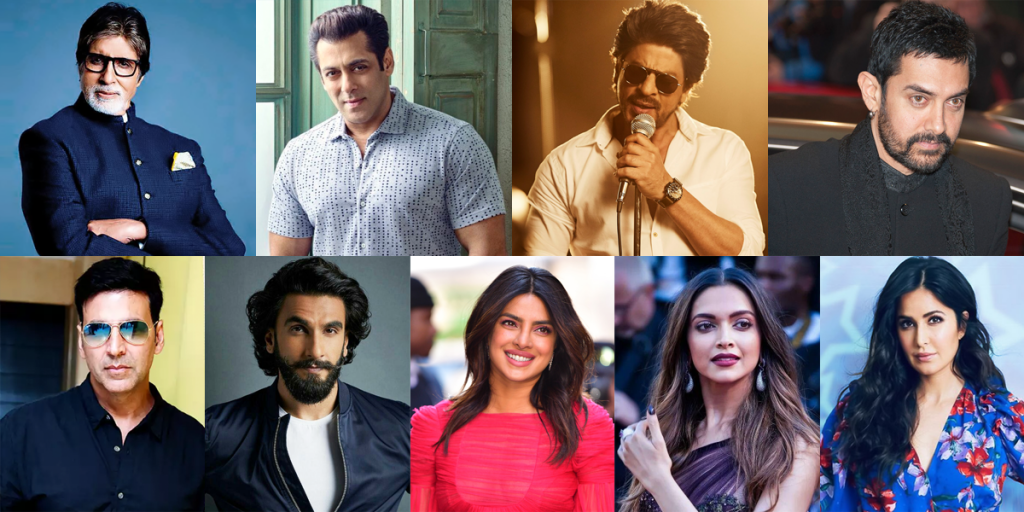
Kollywood
Rajinikanth, Vijay, Ajith Kumar and Nayanthara

Tollywood
Mahesh Babu, Prabhas, Anushka Shetty and Rakul Preet Singh

As a result of these film stars having huge fan-followings from around the world, they too have helped attract large audiences to watch Indian movie releases in cinema.
A recent report by PWC indicates that Bollywood is set to become the third largest cinema market in the world.
In recent years, there have been numerous Indian language movies that have done relatively well at the worldwide box office:
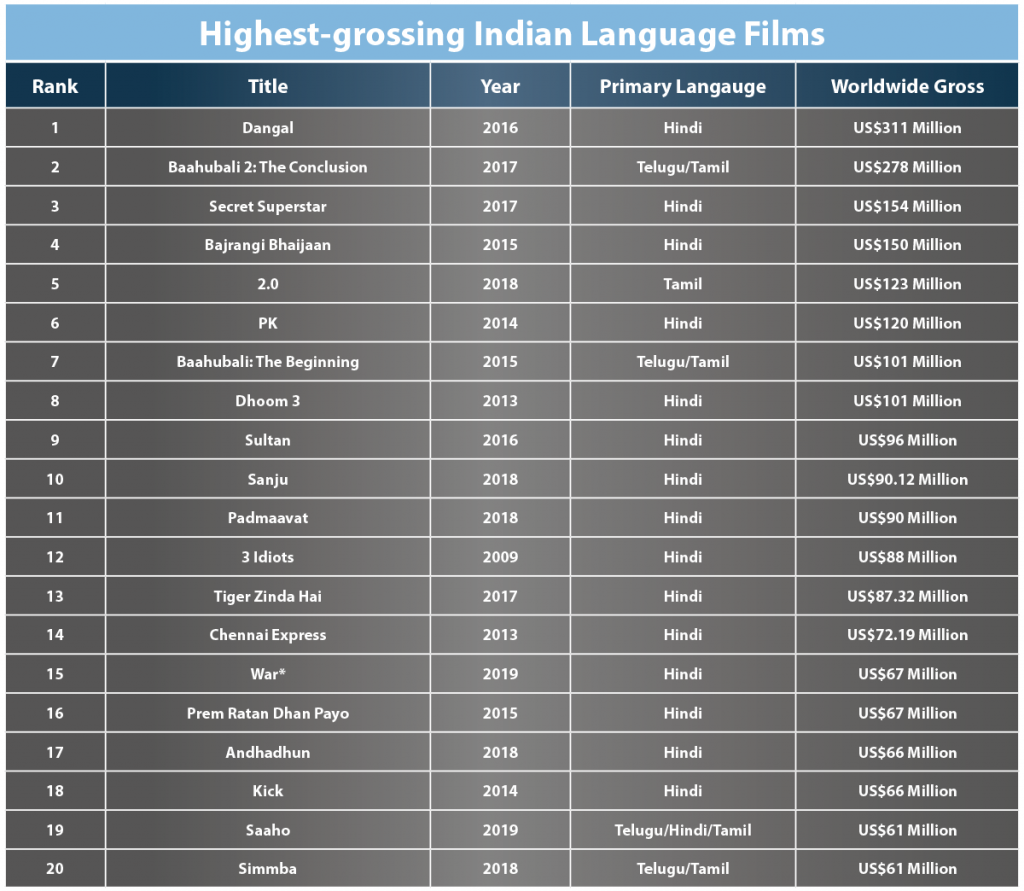
Bollywood movies easily make up the second largest watched language in the UAE – with some blockbusters raking in 300,000 plus admissions. Other Indian language movies – which include Malayalam, Tamil and Telugu, have also gained massive popularity and acceptance in accordance with Hindi movies.
Below is analysis conducted by Motivate Val Morgan on Indian language movie releases across the Middle East in 2018:
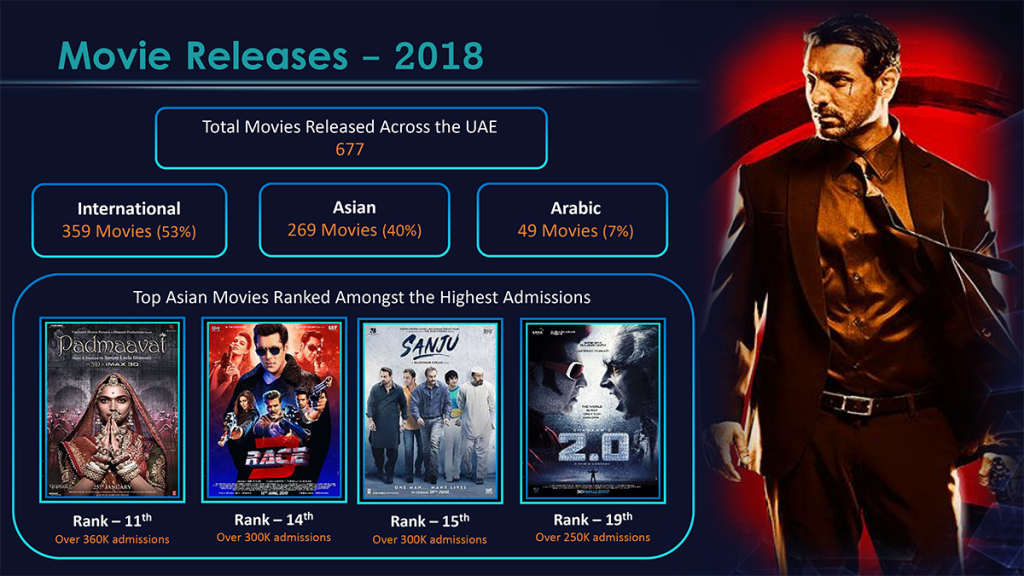
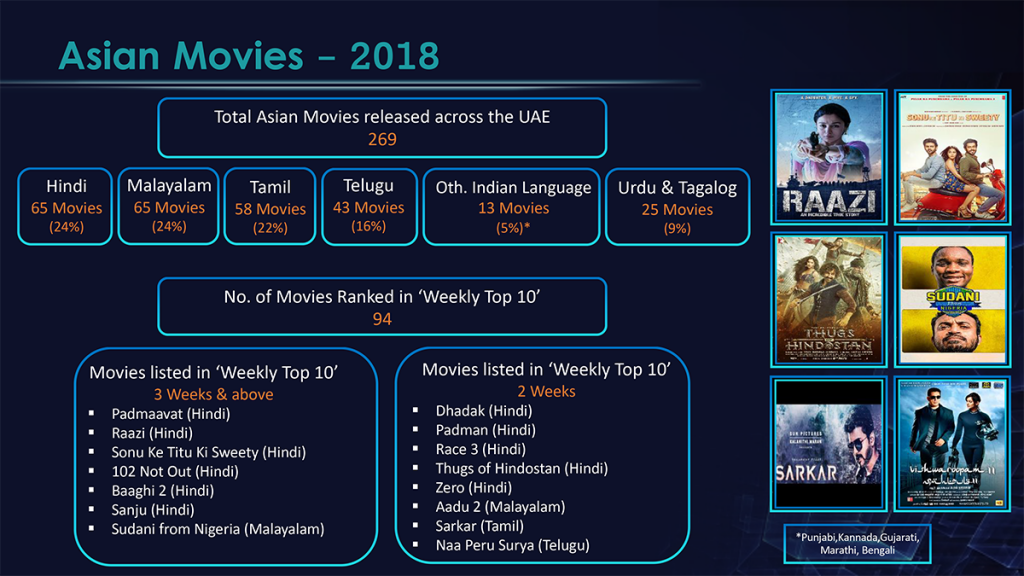
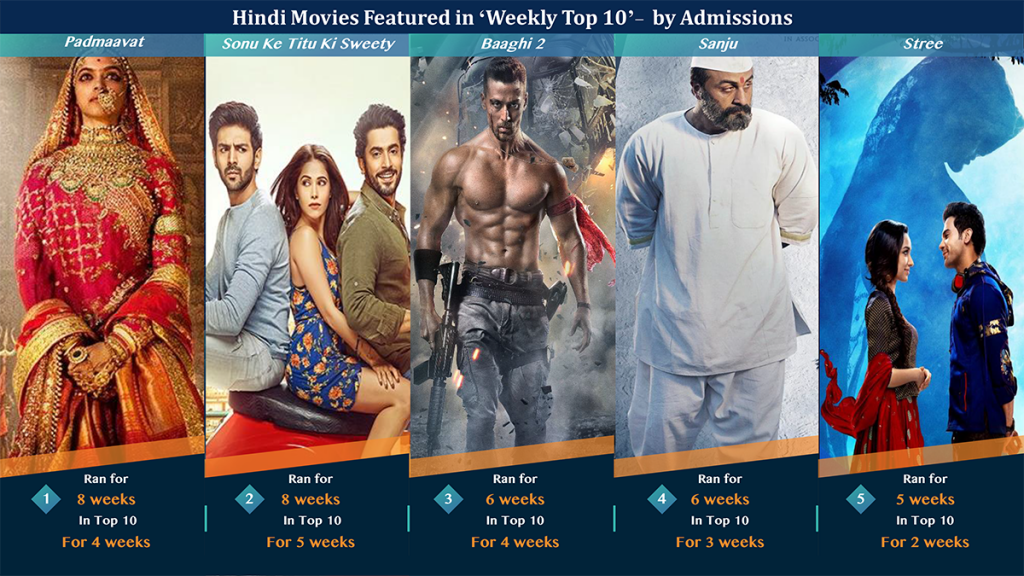
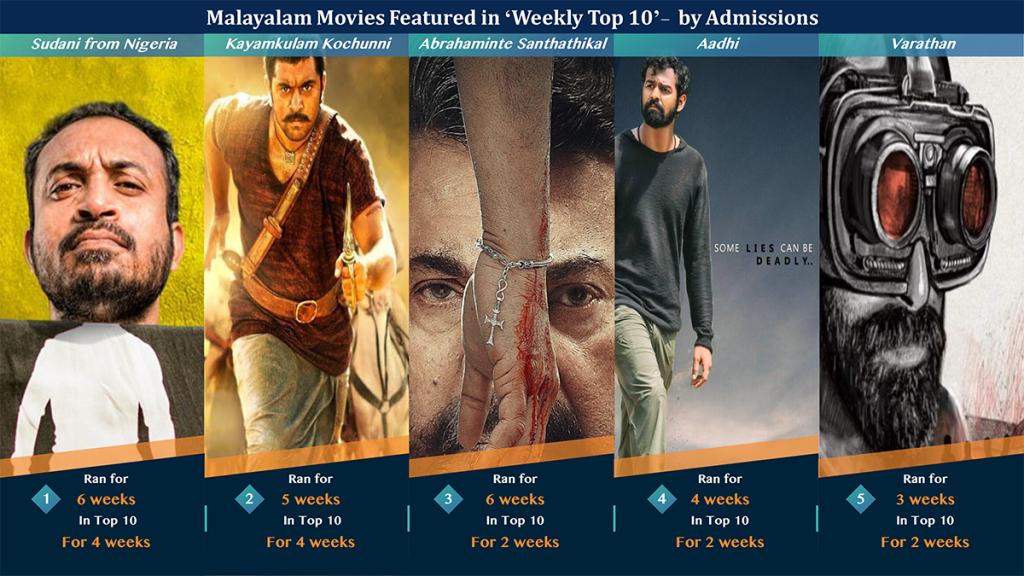
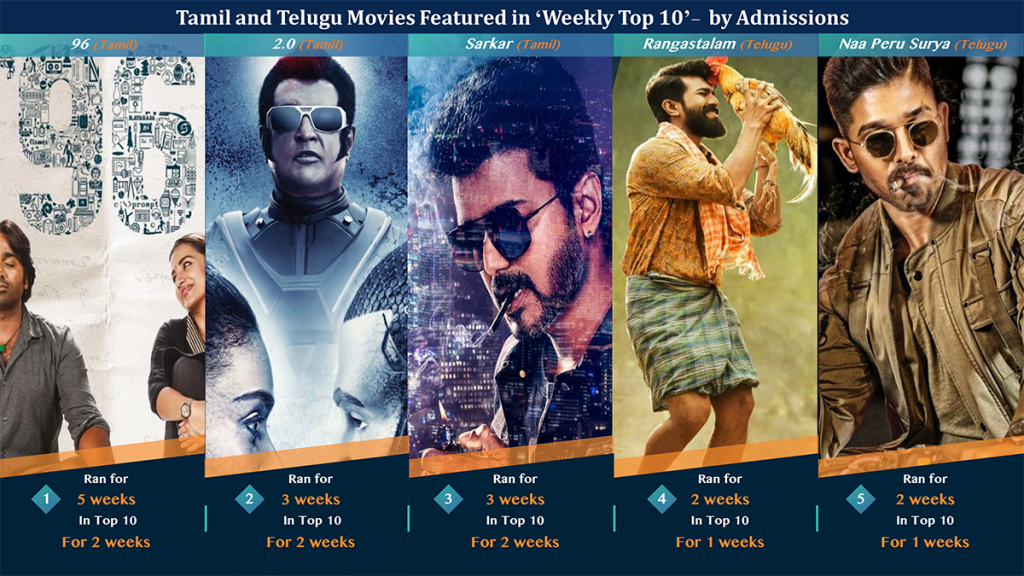
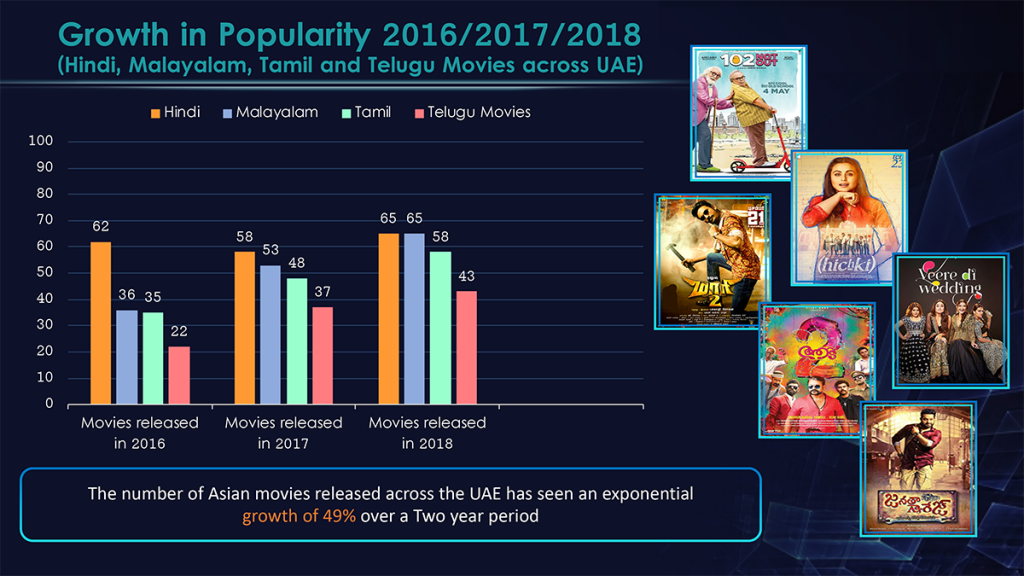
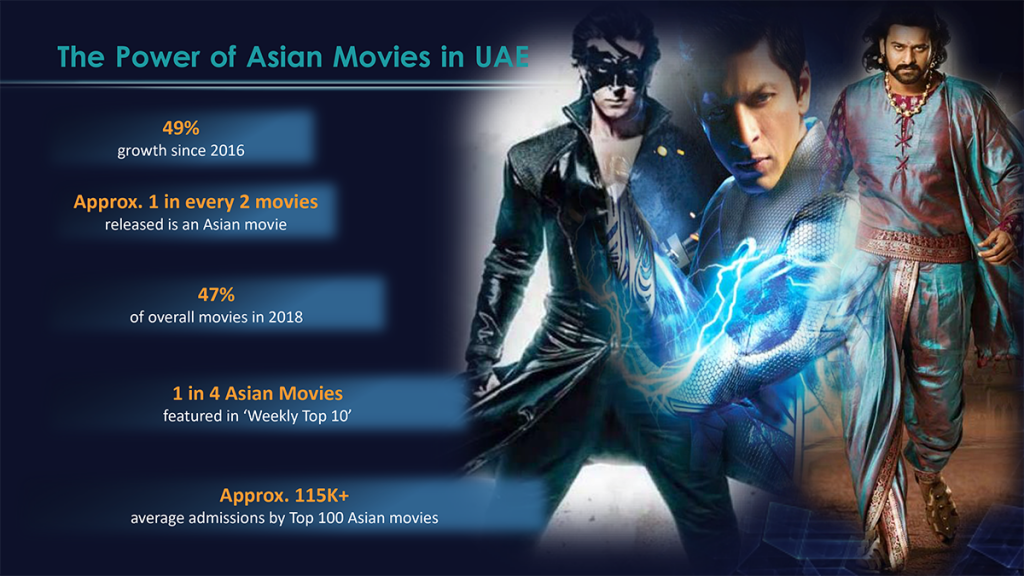
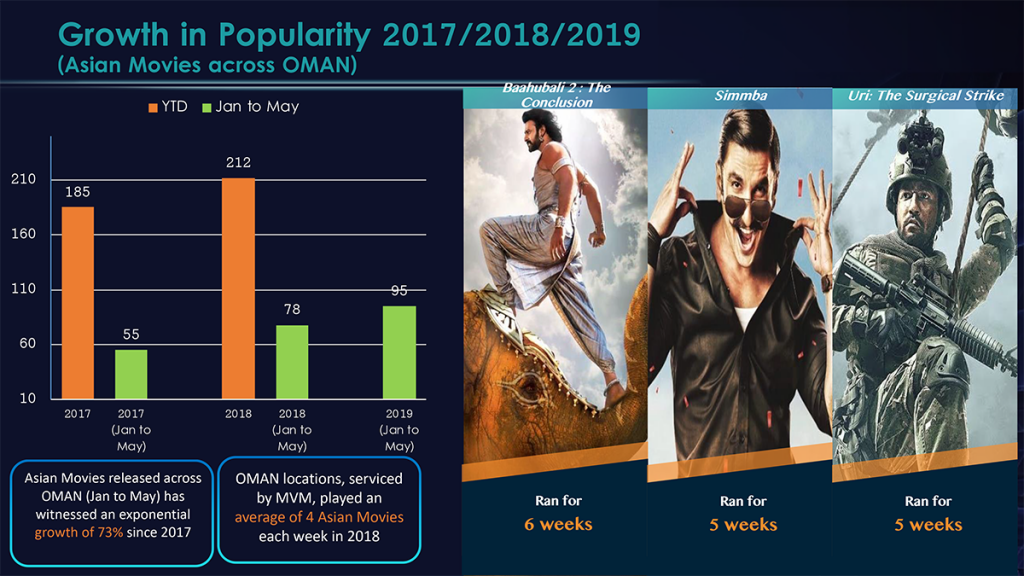
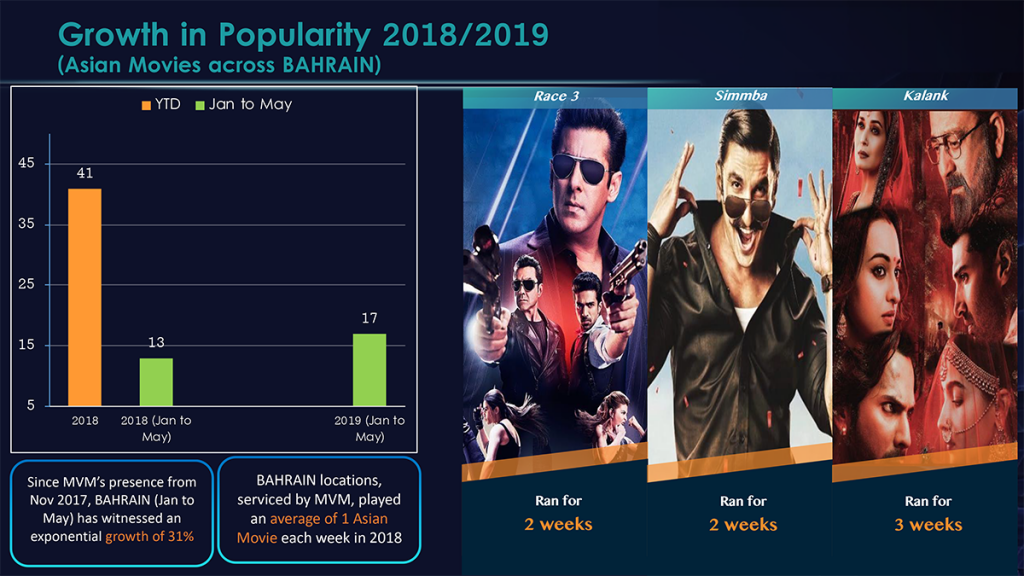
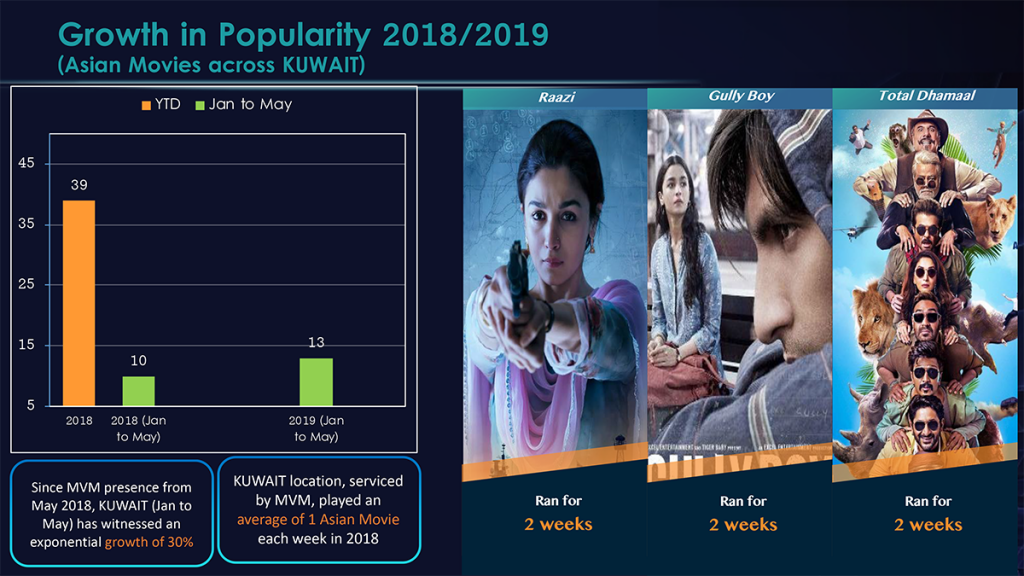
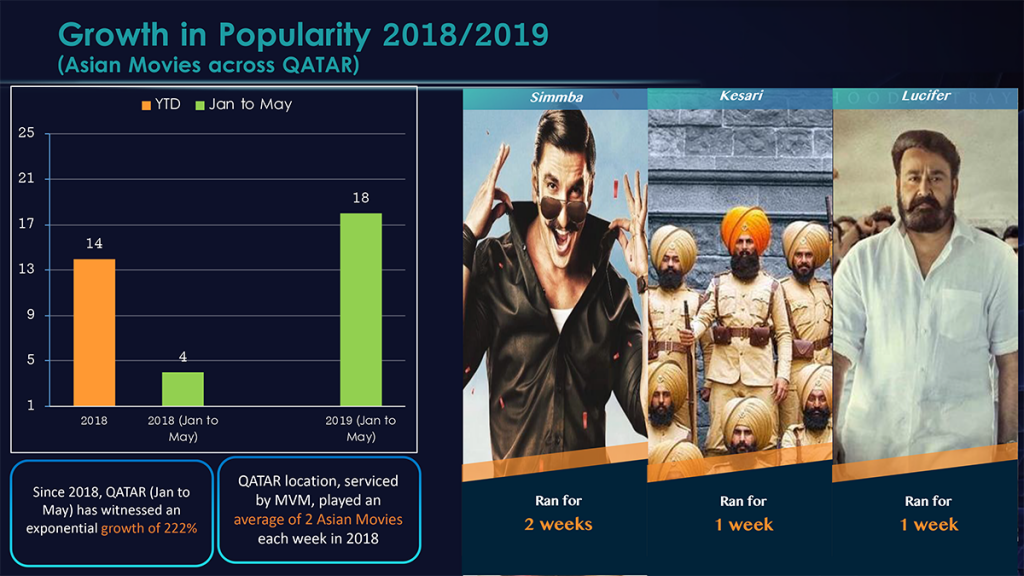
In October 2019, Motivate Val Morgan – in collaboration with Murdoch University Dubai, also conducted cinema research in the UAE in the form of questionnaires and video interviews at VOX Cinemas – City Centre Deira and Burjuman (two prominent locations for Asian movie audiences).
The objective of this research project was to understand cinemagoing habits of Asian audiences and measure the effectiveness of cinema advertising alongside Indian language movies..
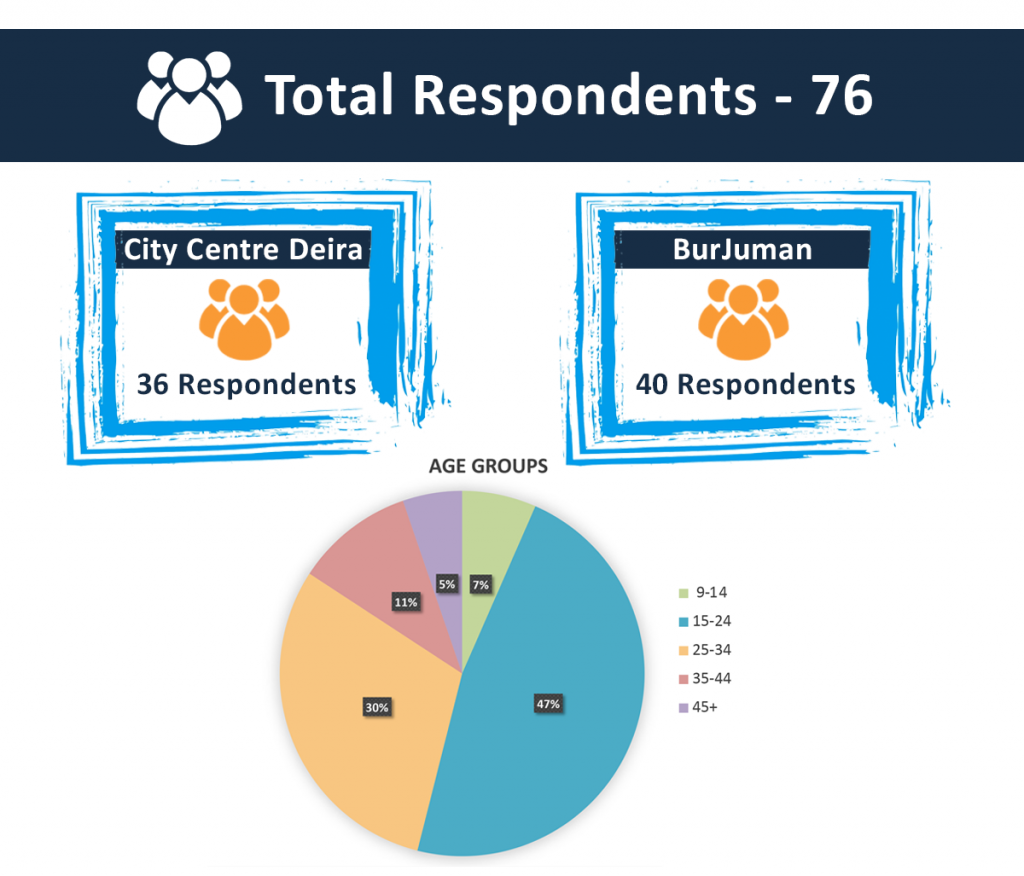
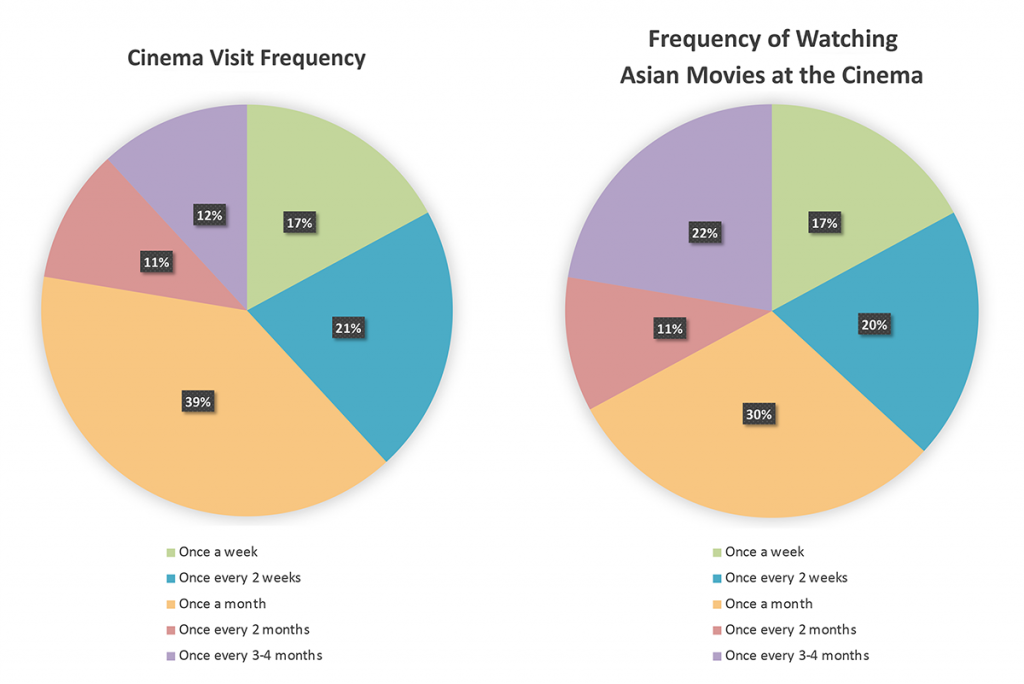
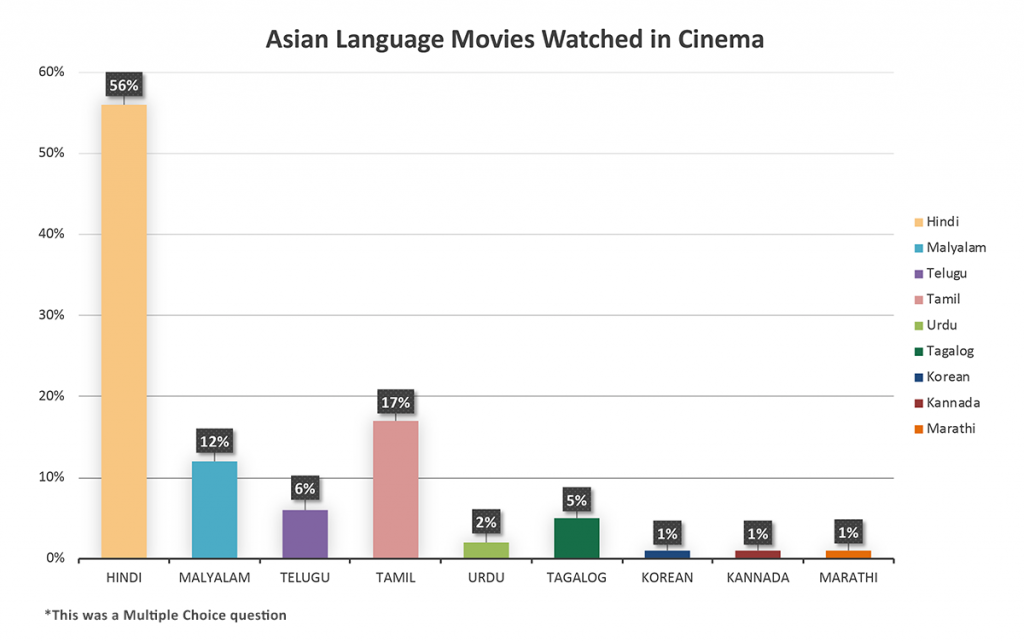
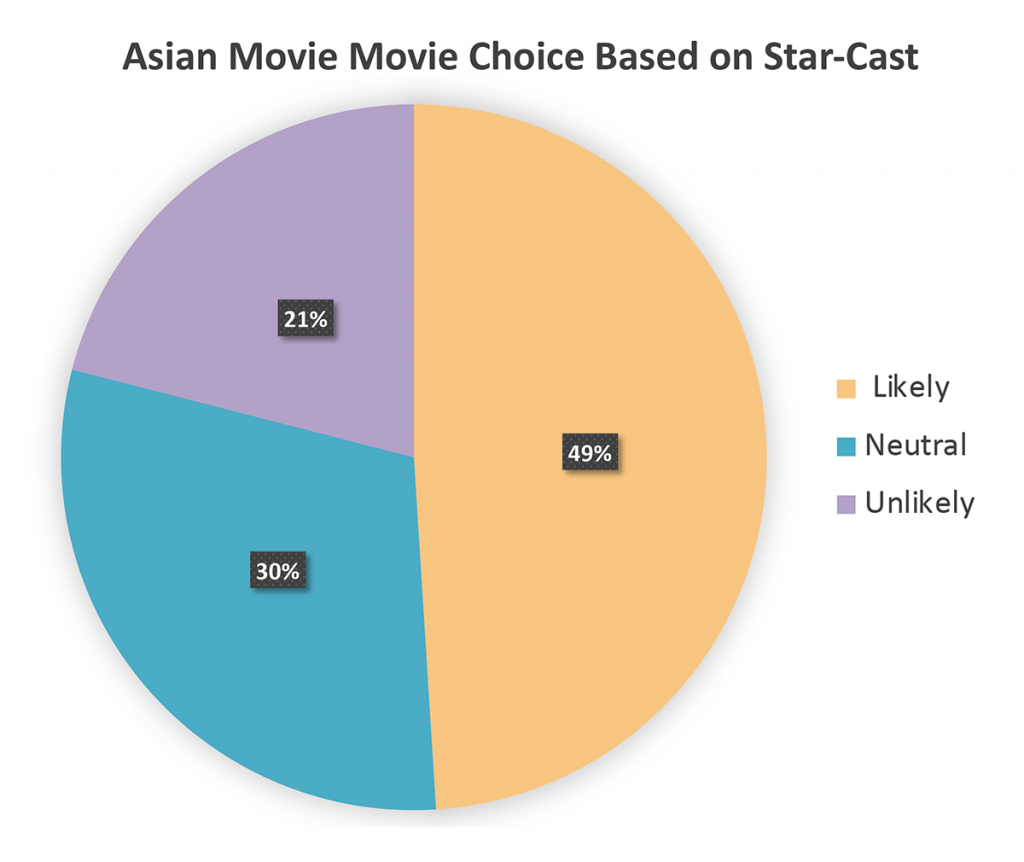
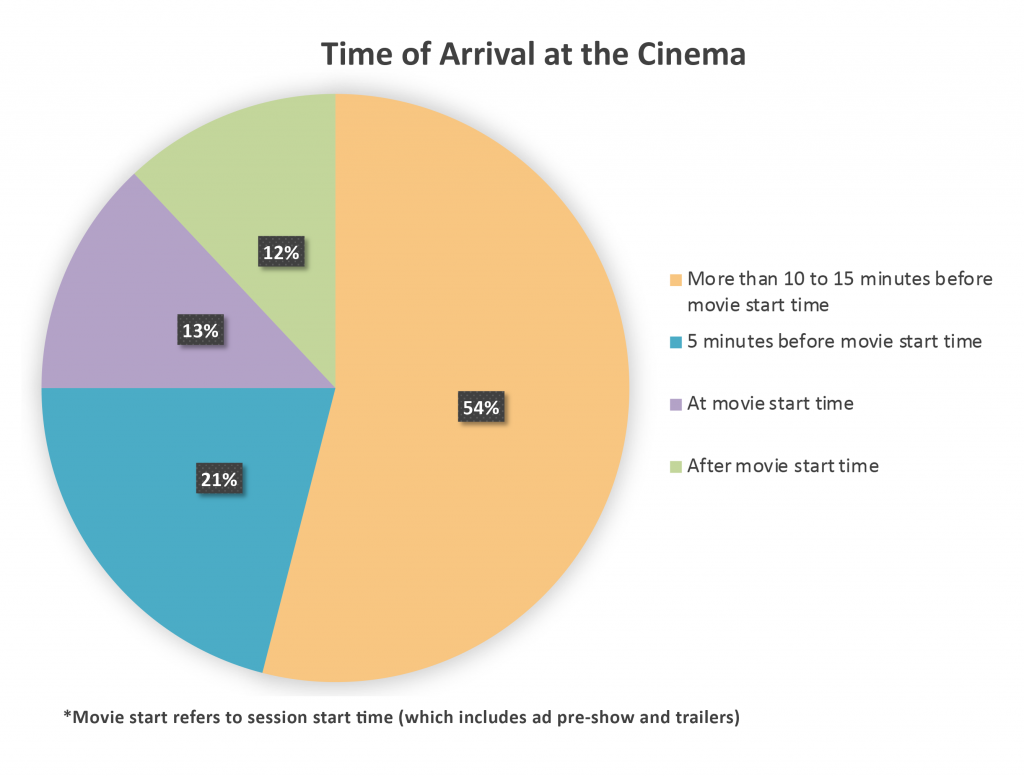
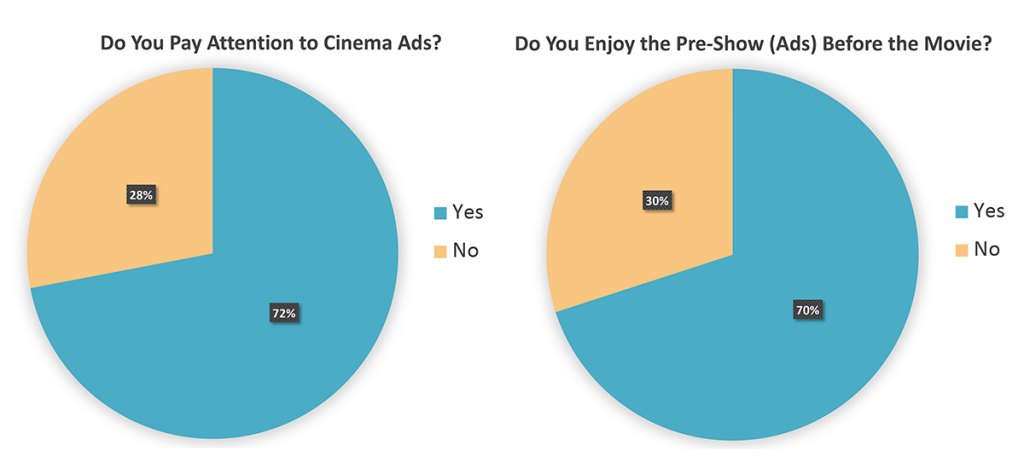
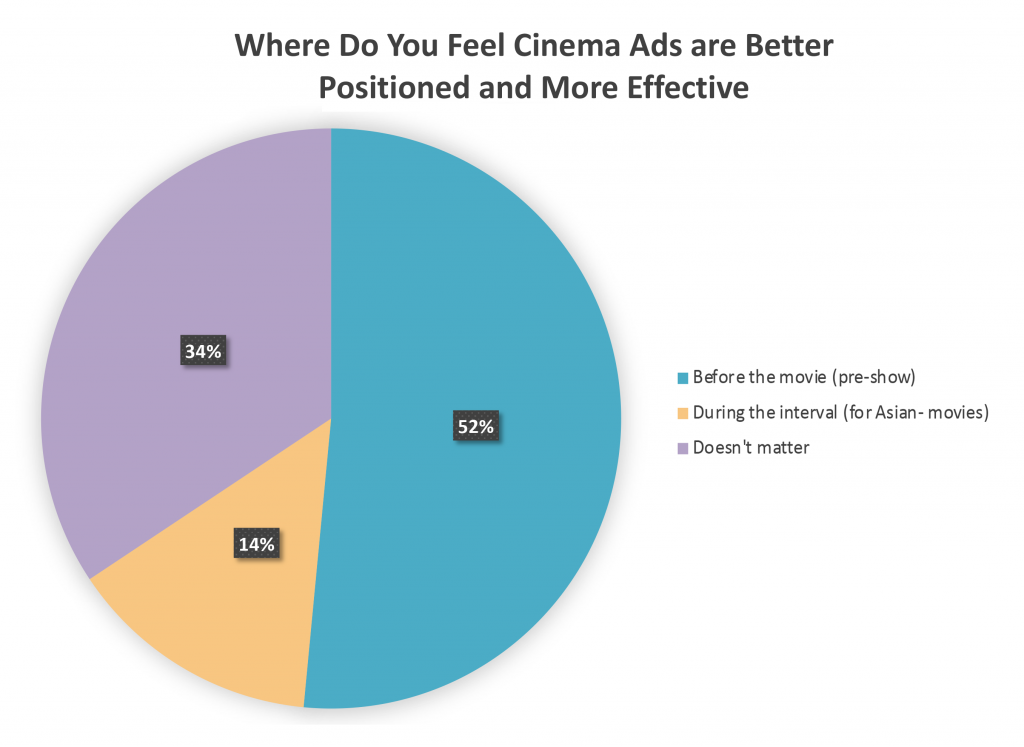
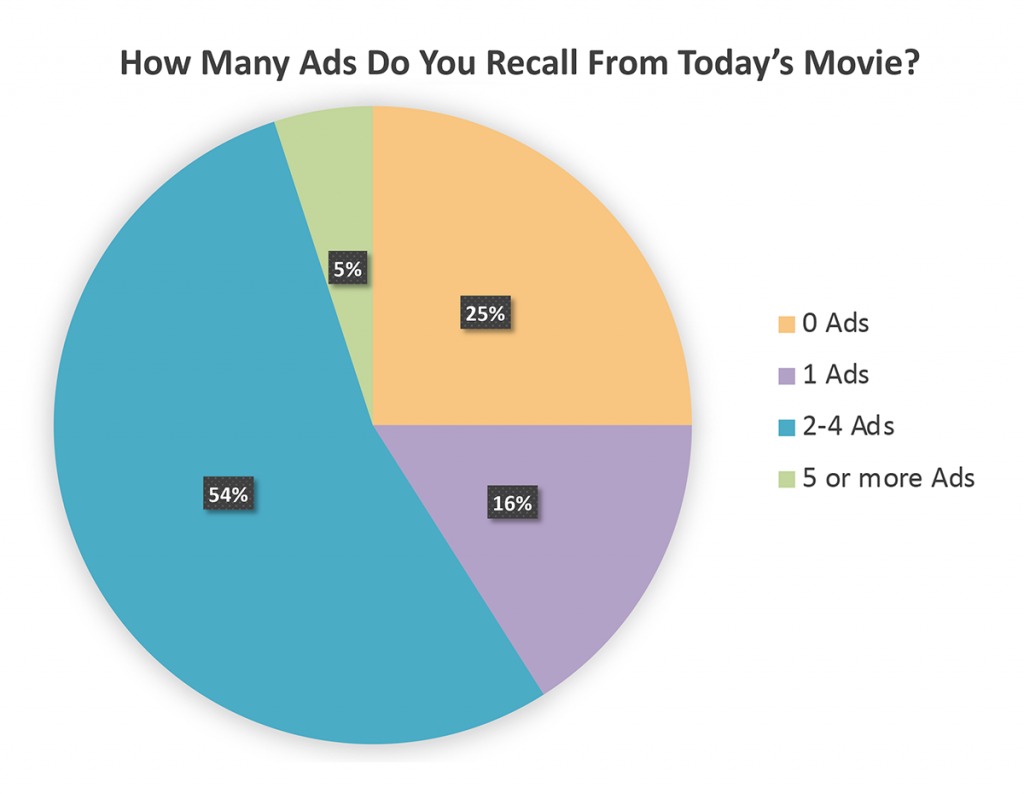
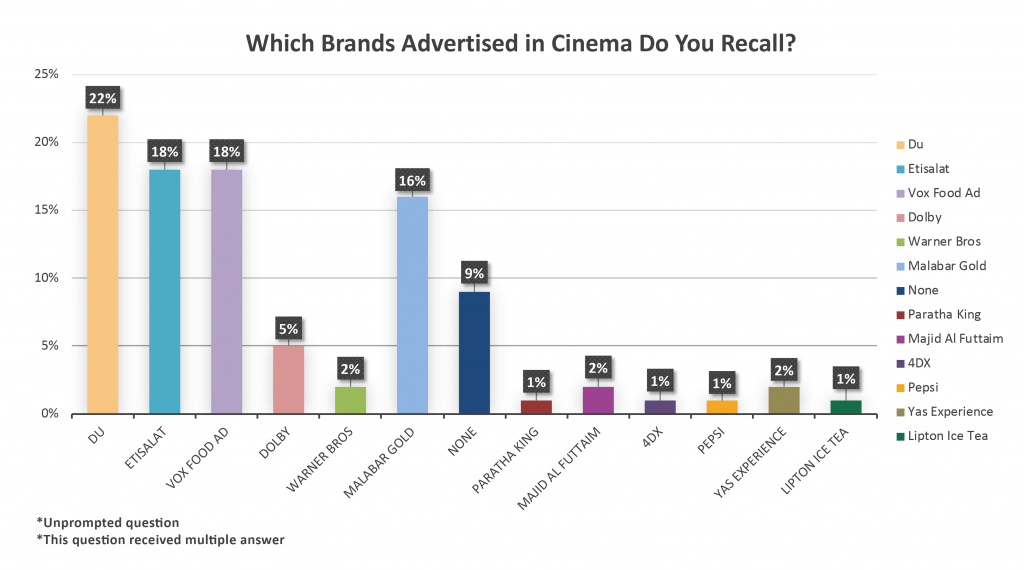

As the research above indicates:
Here’s a line-up of Indian language movies scheduled to release over the months ahead:
December 2019
Pati Patni Aur Woh (Hindi)

Panipat (Hindi)

Mardaani 2 (Hindi)

Good Newwz (Hindi)

Mamangam (Malayalam)
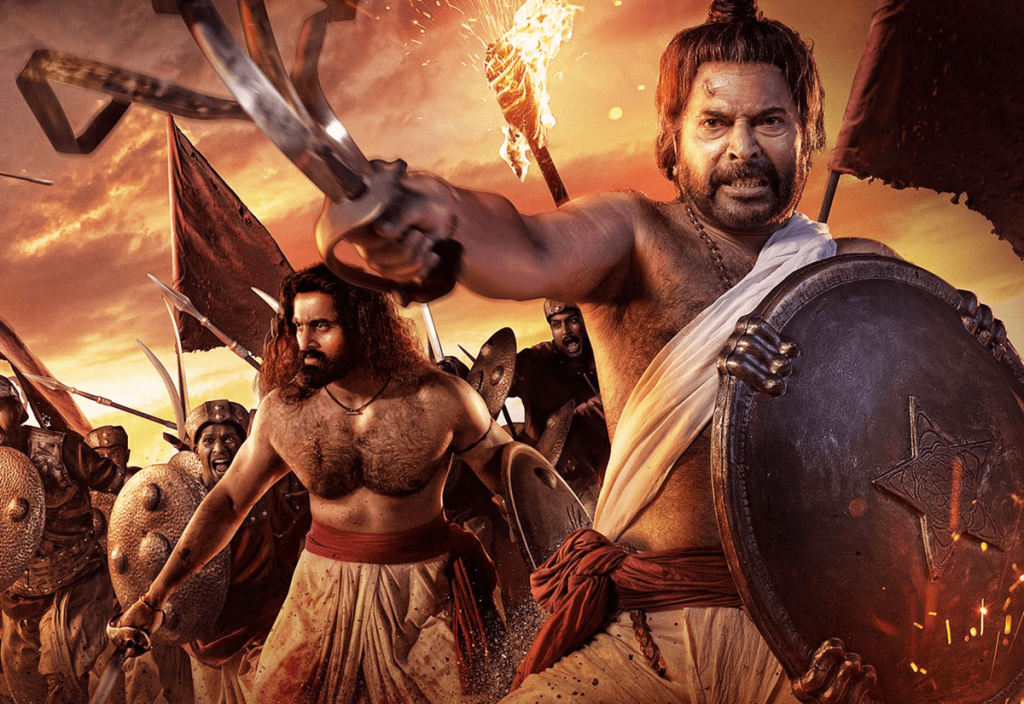
January 2020
Tanhaji: The Unsung Warrior (Hindi)
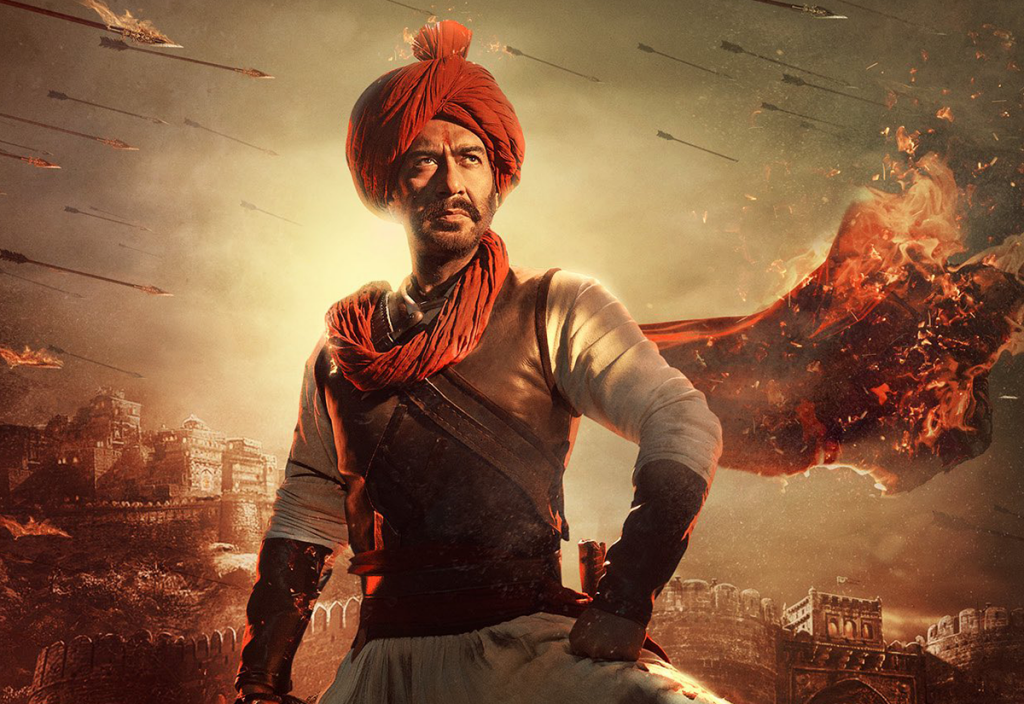
Darbar (Tamil)

Ala Vaikunthapurramloo (Telugu)
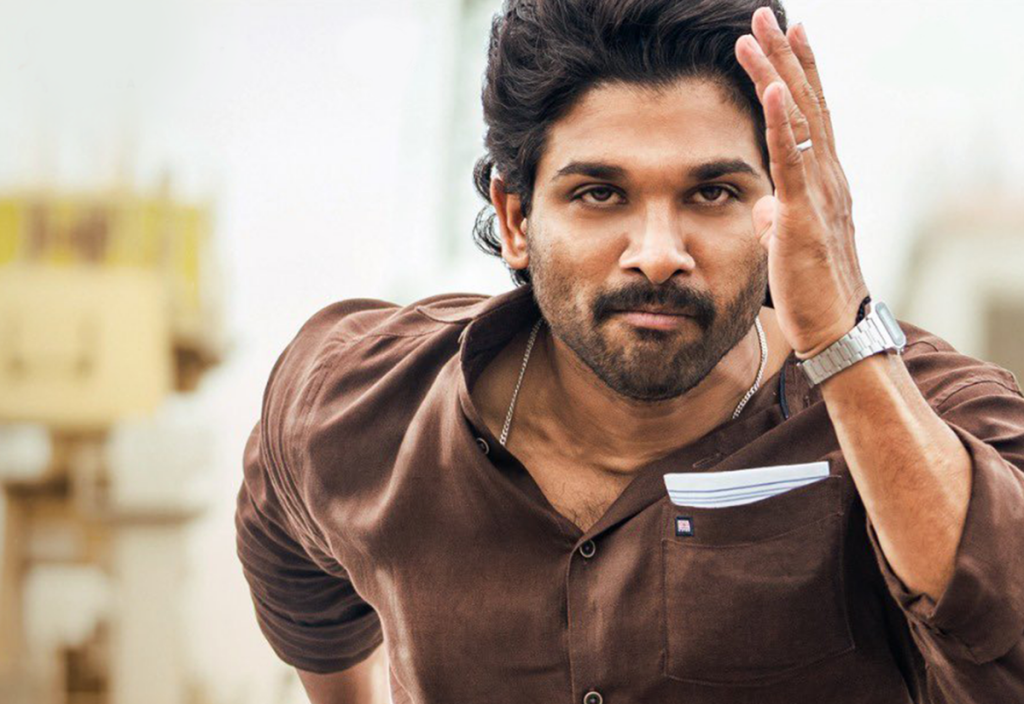
Sarileru Neekevvaru (Telugu)

Street Dancer 3D (Hindi)

Don’t miss out on targeting large Asian movie loving audiences. Contact us for cinema advertising opportunities alongside the movies mentioned above!
Sources: Wikipedia, WARC, MVM Analysis, MVM Research and IMDb
Cinema advertising growth is outpacing all other traditional media, as Netflix’s rise shows no notable impact
The global cinema advertising market is expected to be worth $4.6bn this year, representing a 6.8% rise from 2018. This is ahead of the all media growth forecast by WARC, the international marketing intelligence service, of 4.6% for 2019 (to $624.9bn), and places cinema as the second-fastest growing ad medium this year, behind internet as a whole.
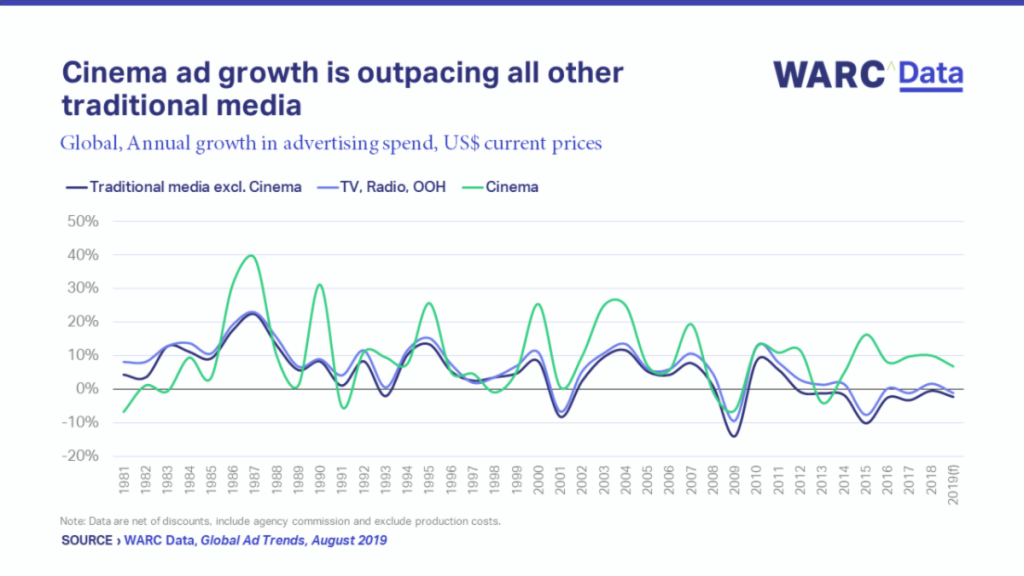
Cinema’s share of global adspend is holding steady
While small, cinema’s 0.7% share of global adspend is expected to hold steady in 2019, making it the only medium other than internet not to lose share. Figures from WARC’s Adspend Database show that cinema’s share of global adspend has dipped only twice since 1980 (1994 and 2013) and growth in cinema ad investment has generally tracked ahead of other traditional media since 1981, and consistently so since 2014.
In Europe, advertisers spend 1.6 times more on cinema per admission than in the US. The UK leads the way, with spend per admission rising from £0.18 in 1980 to £1.43 last year, when 177m admissions were recorded – the highest on record. This despite 46% of UK consumers stating that Netflix is their first choice for watching movies, according to GlobalWebIndex.
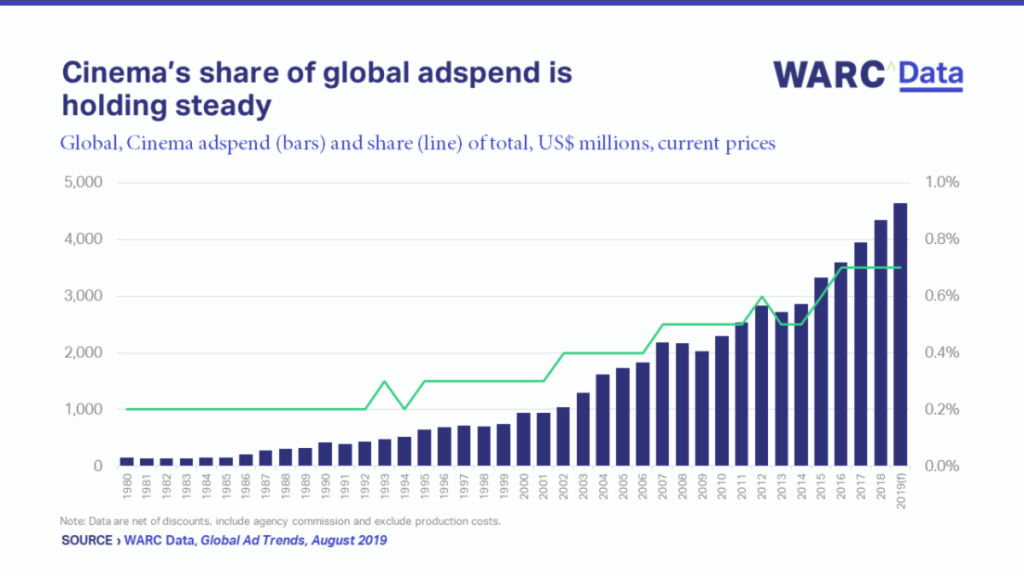
China is driving global growth, US brands are under-investing
China is the largest cinema ad market globally, with RMB11.9bn (US$1.8bn) expected to be spent this year. This equates to a 47.3% share of global cinema adspend when measured in Purchasing Power Parity terms. Further, China has accounted for three quarters (74.9%) of global growth in cinema adspend since 2015, on average, and is expected to contribute 87.4% towards global cinema growth this year. IHS figures suggest that the number of cinema screens in China increased by 9,303 in 2018 alone, or 26 per day on average.
In the US, the world’s second-largest cinema market with a projected value of $735m this year, the medium draws less than half a percent (0.4%) of media budgets on average. Seven product categories allocate more than this, most notably food, for which cinema accounts for 1.5% of all media spend. Non-profit (1.0%), telecoms & utilities (0.7%), alcoholic drinks (0.7%), automotive (0.6%), transport & tourism (0.6%) and financial services (0.5%) also record investment levels above the US average.
DCM recommends that brands invest a minimum of 2.7% of budgets in cinema, with some sectors like travel & tourism seeing optimal levels of campaign ROI when allocating as much as 11%.
Attentive audiences ensure cinema ads get noticed in a brand-safe environment, while young audiences have a positive affinity with the medium
Captive audiences viewing high-quality ads in an emotional atmosphere is a draw for advertisers. Research by Ebiquity has found that Cinema outperforms all other media at triggering an emotional response, guaranteeing a safe environment, and getting ads noticed. However, the medium scores lowest in increasing campaign ROI, maximizing campaign reach, and generating short-term sales.
Cinema attracts a younger, more affluent audience who tend to be lighter TV viewers. According to IPA TouchPoints 6, cinema delivers a more positive emotional experience than any other AV channel (84% of time spent at the cinema is associated with positive emotions for 16+ adults, versus 60-65% for live TV, longform VOD and short online video). Kantar Millward Brown has also found that among ‘Gen Z’ (16-19 year-olds), cinema is the most popular traditional advertising medium with 59% feeling ‘positive about it’ (compared to 34% for print, 38% for TV and 50% for outdoor).
Consumers now spend more on streaming movies than visiting the cinema, but Netflix has yet to hit the box office
Data from the Motion Picture Association of America (MPAA) show that the amount consumers spend on digital home entertainment, including on online subscriptions such as Netflix, surpassed the amount spent at the cinema globally for the first-time last year ($42.6bn versus $41.1bn). This landmark had already been reached in the US during 2015.
Over the course of an average year, a Netflix subscription will cost a consumer US$113.16. This compares to the $45.55 a North American will spend at the cinema each year on average, with the equivalent figures for the UK and the EU at $25.13 and $11.04 respectively.
In the US, a moviegoer visited the cinema five times on average in 2018, which roughly equates to 263m consumers going every two months. But with almost three-quarters (74%) of Americans now using an online subscription – and 84% using a pay TV channel – to watch a movie at least 2-3 times each month, viewership in the living room may have reached parity with the silver screen.
James McDonald, Managing Editor, WARC Data, and author of the research, says: “The experiential nature of cinema places it in a different bracket to SVOD services, which instead occupy a similar space to traditional TV. This, coupled with the exclusivity of box office hits – particularly franchises – should ensure any downward pressure from SVOD services is minimal in the short term.
“Cinema offers advertisers access to younger, more affluent audiences who have an affinity with the medium. This enables ads to be screened in a brand safe environment where they will be noticed, often in a location that is close to a retail outlet and, by extension, a point of purchase.”
Global media analysis – Cinema
Other key media intelligence new on WARC Data
Global Ad Trends, a monthly report which draws on WARC’s dataset of advertising and media intelligence to take a holistic view on current industry developments, is part of WARC Data, a dedicated online service featuring current advertising benchmarks, forecasts, data points and trends in media investment and usage.
Download a sample report of WARC’s latest Global Ad Trends report on Cinema.
Source: WARC
WARC recently launched a new white paper ‘Anatomy of Effectiveness’ at the Cannes Lions International Festival of Creativity 2019
The white paper for brand marketers and advertising agencies alike, highlights five key priorities for brands seeking greater impact:
The report highlights that every element involves trade-offs and hard decisions on where to invest, and that insights and creative thinking are required to bring it all to life. But, it’s here that brands will drive better customer engagement.
It also looks at what is changing in a fast-moving industry, featuring expert comment from the likes of Les Binet, Peter Field and Jenni Romaniuk of the Ehrenberg-Bass Institute.
A key takeaways from the section ‘Plan for reach’; which Motivate Val Morgan continues to emphasize when in talks with clients, is the fact that multi-channel integrated campaigns are more effective than single-channel campaigns, particularly when they work together to increase reach.
One way to go about this would be to have longer-form ads in quality media placements such as cinema to build brand awareness, while shorter-form ads online and on TV for activations and promotions.
As per the white paper by WARC, a 2016 study conducted for the Advertising Research Foundation found that investing in cross-platform campaigns delivers a significantly higher ROI. Specifically, going from one platform to two increases marketing ROI by 19%.
Click here to download the white paper and learn how your brand could increase marketing effectiveness.
With an amazing line-up of blockbusters ahead: Fast & Furious Presents: Hobbs & Shaw (August), Once Upon a Time … in Hollywood (August), Mission Mangal (August), Saaho (August), IT Chapter Two (September), Rambo: Last Blood (September), The Joker (October), Gemini Man (October), Terminator: Dark Fate (October), War (October), Doctor Sleep (November), Frozen 2 (November), Jumanji: The Next Level (December); Star Wars: The Rise of Skywalker (December), Bramastra (December), Dabangg 3 (December) and much more, contact us to make cinema an integral part of your media plan.
Sources: WARC and Cannes Lions
How would you describe advertising of this day and age in one word? Overwhelming?
Over a hundred years ago, marketeers could choose to communicate messages through two main mediums – newspaper and radio (the first mass media form of communication that offered near real-time delivery).
Today, there is an arsenal of channels available for marketeers to convey their message – newspaper, radio, magazine, television, digital and SMS, which has led to audiences becoming immune to relentless brand messaging.
In April 2017, Procter and Gamble, one of the world’s largest advertisers, blasted the ad industry for overwhelming consumers with advertising. “There’s too much crap,” said P&G’s chief brand officer Marc Pritchard, in a speech to the American Association of Advertising Agencies – in a transcript seen by CNBC.
“We bombard consumers with thousands of ads a day, subject them to endless load times, interrupt them with pop-ups and overpopulate their screens and feeds,” he said.
With audiences tuning out as a result of advertising overload, how can brands effectively reach their target audience in this day and age?
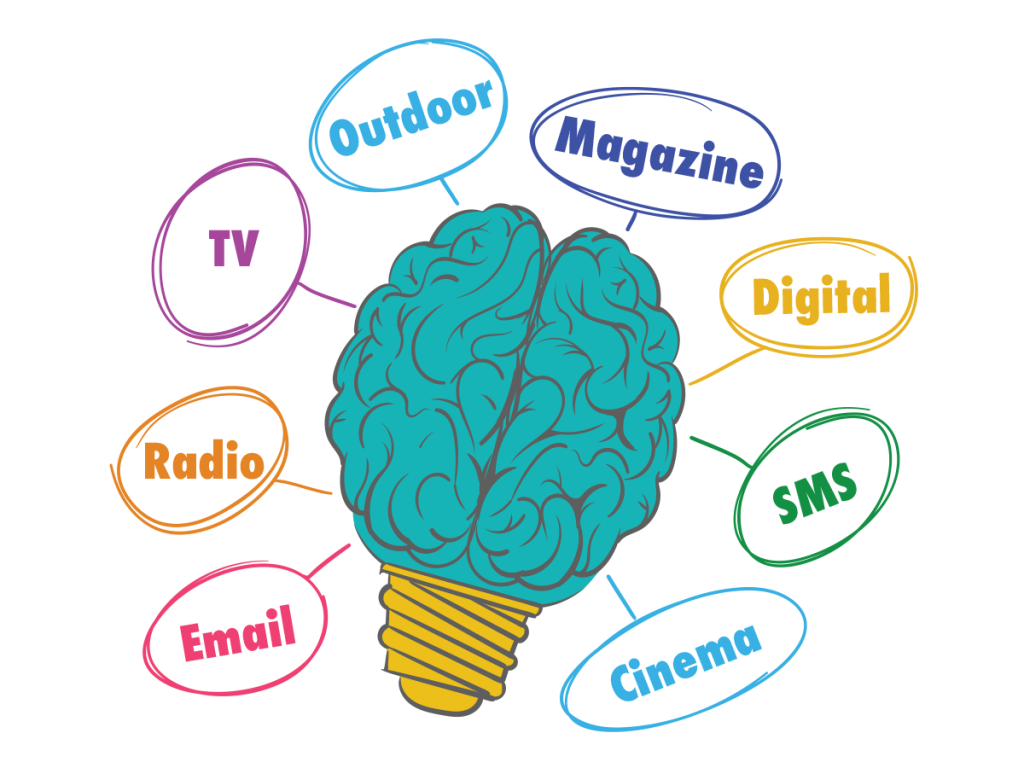
New research by MESH Experience – commissioned by SAWA, suggests that cinema is a powerful marketing platform, ideal for boosting brand influence.
The study captured and analyzed over 4,500 brand experiences from more than 1200 people across 3 countries using MESH’s proprietary ‘Real-time Experience Tracking’ approach. The categories covered in the study comprise Automotive, Finance, Services, FMCG and Electronics. Participating organizations included National CineMedia (USA), Screenvision Media (USA), Cineplex Media (Canada), and Weischer Media (Germany).

Information displayed in image courtesy MESH Experience
Below are key insights that analyses the role of cinema vs. other media:
As context for this study, and pointed out by a recent Deloitte study, it is no longer enough for brands to simply communicate features and benefits because people want to understand more about the brand’s social purpose, particularly younger people. We also know that people are overloaded with information and this probably explains why in this MESH study we saw that more than a third of paid media messages are self-reported as making people feel “neutral” towards the brand.

Information displayed in image courtesy MESH Experience
Consumer information overload is creating a challenge for brands wanting to convey more complex concepts to customers who are time-poor with less attention to give.
The study conducted by MESH Experience discovered that the cinema environment delivers the greatest proportion of positive brand experiences vs. any other media with 2 out of 3 experiences being positive and virtually no negative experiences.
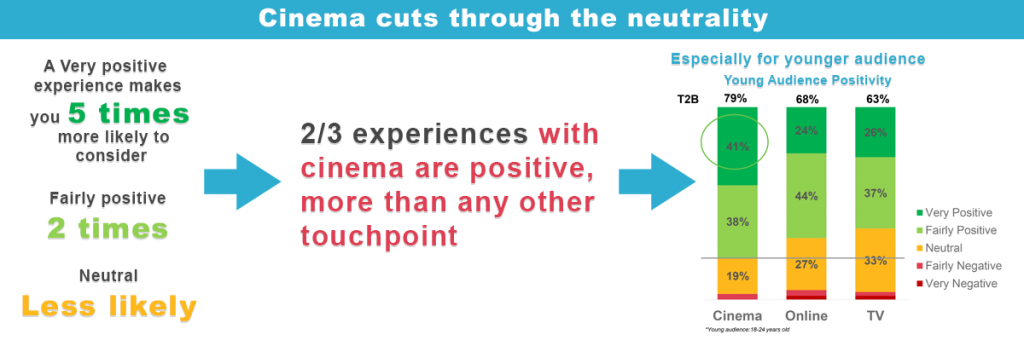
Information displayed in image courtesy MESH Experience

Information displayed in image courtesy MESH Experience
And this emotional engagement, where people spontaneously tell us their experience is positive, is leading to much deeper advertising comprehension:
Spontaneous descriptions for cinema brand experiences generated a word count that was 20% longer than those for online experiences and 12% longer than for TV.

Information displayed in image courtesy MESH Experience
These comments conveyed detailed product descriptions as well as depth of emotion.
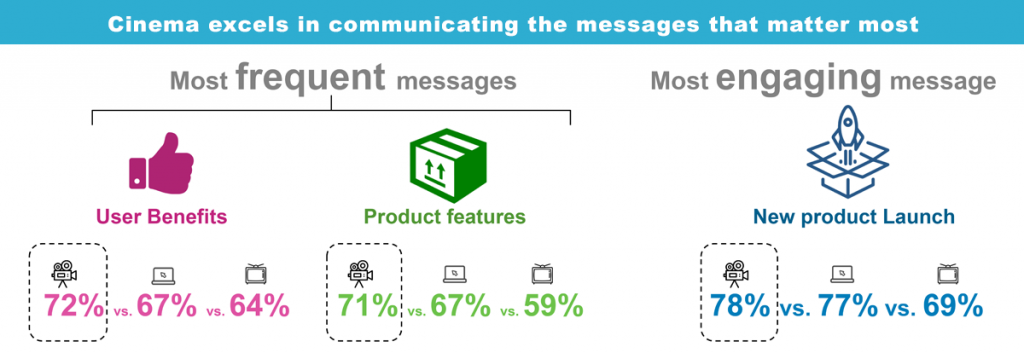
Information displayed in image courtesy MESH Experience
Cinema is generally perceived to be an awareness building medium, however, this study saw how brand experiences in cinema generate action:
Study participants who experienced brand messages in Cinema were 43% more likely to feel inspired to find out more about the brand vs. brand experiences with other media.

Information displayed in image courtesy MESH Experience

Information displayed in image courtesy MESH Experience
And the depth of a cinema brand experience makes people feel 50% more connected to others which can lead to conversation, and we see is a key driver of brand consideration.

Information displayed in image courtesy MESH Experience
There is a direct relationship between building emotional connections and establishing brand recall value, and cinema advertising allows brands to craft concrete and solid brand images in the minds of their consumers. Creating brand recall is the crucial element required in pushing sales and driving revenue.
Cinema advertising allows brands to paint a picture on a larger canvas, deliver a story with a louder voice, and communicate a message with more focused attention – all of which combine to make it the only Superhero among all advertising mediums.
Fiona Blades, President and Chief Experience Officer, MESH Experience commented “What we have discovered is that cinema has the power to penetrate deeper to connect brands to people. Even if the same creative is shown repeatedly in another medium, it may never hit the high notes of one cinema viewing. This shows the vital role that cinema can play in a brand’s media mix. And is why, when you add cinema to other media, such as TV and online, it turbocharges the impact on brand consideration.”
Cheryl Wannell, CEO, SAWA, continued “As an industry we believe in creating trustworthy environments for advertisers to communicate in. What better place to help customers understand a brand’s purpose than Cinema. This research once again validates the strength of the Cinema medium as viable choice in any campaign especially when trying to engage the hard to reach demographics of Millennials and Generation Z.”
As a result of these initial findings, a second phase is already in the works for 2019.
Motivate Val Morgan is a full member of SAWA (Global Cinema Advertising Association)
Sources: SAWA, MESH Experience, CNBC, Research News Live and On Digital Marketing